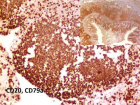Abstract
Research Article
Dead sea salt solution: composition, lack of cytotoxicity and in vitro efficacy against oral leukotoxins, endotoxins and glucan sucrose
Hessam Nowzari*, Mao-Chi Tuan, Michael Jorgensen, Marie-Grace Michel and Jean-Francois Michel
Published: 23 July, 2022 | Volume 6 - Issue 1 | Pages: 009-014
Introduction: Dead Sea Salt, rich in minerals and ionic compositions and low in Sodium Chloride (NaCl) has many reported unique properties that set it apart from other salts.
Objectives: To evaluate the composition of Dead Sea Salt and assess its in vitro cytotoxicity, and efficacy against oral bacterial leukotoxins, oral endotoxins and oral glucan sucrase.
Methods: The cytotoxicity was evaluated in an established cell line (solution at 5000 µg/mL of culture medium) using positive and negative control groups. The effect on oral bacterial leukotoxin (LtxA) and different concentrations of lipopolysaccharide and glucan sucrase was established at 24, 36, 48, 60, 72, 84, and 96 hours using the HPLC method (high-performance liquid chromatography).
Results: The most predominant elements detected were the water of crystallization (H2O, water that is found in the crystalline framework of salt and which is not directly bonded ), magnesium chloride (MgCl2), potassium chloride (KCl), sodium chloride (NaCl), calcium chloride (CaCl2), bromide (Br -) and sulfates (SO4). In vitro, Dead Sea Salt presented no cytotoxicity and was highly effective against leukotoxin, endotoxin, and glucan sucrase enzyme.
Conclusion and clinical significance: We believe that rinsing with Dead Sea Salt has the potential to contribute to the prevention of periodontal, peri-implant and dental disease and merits clinical research.
Read Full Article HTML DOI: 10.29328/journal.ibm.1001021 Cite this Article Read Full Article PDF
References
- Long-Term changes in the Dead Sea. Israel Oceanographic and Limnological Research - Israel Marine Data Center (ISRAMAR).
- Grillo A, Salvi L, Coruzzi P, Salvi P, Parati G. Sodium Intake and Hypertension. Nutrients. 2019 Aug 21;11(9):1970. doi: 10.3390/nu11091970. PMID: 31438636; PMCID: PMC6770596.
- Kaup Y, Schmid M, Middleton A, Weser U. Borate in mummification salts and bones from Pharaonic Egypt. J Inorg Biochem. 2003 Mar 1;94(3):214-20. doi: 10.1016/s0162-0134(03)00002-3. PMID: 12628701.
- Pedanius Dioscurides. Of medical matter. Naples, Biblioteca Nazionale, Athens: Militos Editions, 1999.
- White GE, Armaleh MT. Tongue scraping as a means of reducing oral mutans streptococci. J Clin Pediatr Dent. 2004 Winter;28(2):163-6. doi: 10.17796/jcpd.28.2.n18275821658263v. PMID: 14969377.
- Bearman G, Ocean chemistry and deep-sea sediments, Pergamon: Sydney, 1989.
- Sukenik S, Flusser D, Codish S, Abu-Shakra M. Balneotherapy at the Dead Sea area for knee osteoarthritis. Isr Med Assoc J. 1999 Oct;1(2):83-5. PMID: 10731301.
- Katz U, Shoenfeld Y, Zakin V, Sherer Y, Sukenik S. Scientific evidence of the therapeutic effects of dead sea treatments: a systematic review. Semin Arthritis Rheum. 2012 Oct;42(2):186-200. doi: 10.1016/j.semarthrit.2012.02.006. Epub 2012 Apr 12. PMID: 22503590.
- Hermann K. On the etiology and therapy of alveolar pyorrhoea with special consideration of the Karlovy Vary thermal baths and their products as a healing factor. Franieck'sche Buchdruckerei, Karlsbad. 1905.
- Michel JF, Michel MG, Nadan J, Nowzari H. The street children of Manila are affected by early-in-life periodontal infection: description of a treatment modality: sea salt. Refuat Hapeh Vehashinayim (1993). 2013 Jan;30(1):6-13, 67. PMID: 23697295.
- Rodriguez AE, Ajdaharian J, Effects of a Novel Mouthwash on Plaque Presence and Gingival Health, Dentistry 2017, 7:11, DOI:10.4172/2161-1122.1000460.
- Ajdaharian J, Takesh T, Anbarani A, Ho J, Wilder-Smith P. Effects of a Novel Mouthwash on Dental Remineralization. Dentistry (Sunnyvale). 2017;7(5):432. doi: 10.4172/2161-1122.1000432. Epub 2017 May 5. PMID: 29629237; PMCID: PMC5886359.
- Ito K, Ito S, Shimamura T, Weyand S, Kawarasaki Y, Misaka T, Abe K, Kobayashi T, Cameron AD, Iwata S. Crystal structure of glucansucrase from the dental caries pathogen Streptococcus mutans. J Mol Biol. 2011 Apr 29;408(2):177-86. doi: 10.1016/j.jmb.2011.02.028. Epub 2011 Feb 25. PMID: 21354427.
- Devulapalle KS, Mooser G. Glucosyltransferase inactivation reduces dental caries. J Dent Res. 2001 Feb;80(2):466-9. doi: 10.1177/00220345010800021301. PMID: 11332534.
- Proksch E, Nissen HP, Bremgartner M, Urquhart C. Bathing in a magnesium-rich Dead Sea salt solution improves skin barrier function, enhances skin hydration, and reduces inflammation in atopic dry skin. Int J Dermatol. 2005 Feb;44(2):151-7. doi: 10.1111/j.1365-4632.2005.02079.x. PMID: 15689218.
- Portugal-Cohen M, Cohen D, Ish-Shalom E, Laor-Costa Y, Ma'or Z. Dead Sea minerals: New findings on skin and the biology beyond. Exp Dermatol. 2019 May;28(5):585-592. doi: 10.1111/exd.13918. PMID: 30903724.
- Riss T, Niles A, Moravec R, Karassina N, Vidugiriene J. Cytotoxicity Assays: In VitroMethods to Measure Dead Cells. 2019 May 1. In: Markossian S, Grossman A, Brimacombe K, Arkin M, Auld D, Austin C, Baell J, Chung TDY, Coussens NP, Dahlin JL, Devanarayan V, Foley TL, Glicksman M, Haas JV, Hall MD, Hoare S, Inglese J, Iversen PW, Kales SC, Lal-Nag M, Li Z, McGee J, McManus O, Riss T, Saradjian P, Sittampalam GS, Tarselli M, Trask OJ Jr, Wang Y, Weidner JR, Wildey MJ, Wilson K, Xia M, Xu X, editors. Assay Guidance Manual [Internet]. Bethesda (MD): Eli Lilly & Company and the National Center for Advancing Translational Sciences; 2004–. PMID: 31070879.
- National Institute for Health and Care Excellence (Website) Cytotoxic Drugs. 2021. https://bnf.nice.org.uk/treatment-summary/cytotoxic-drugs.html
- Russo PA, Nowzari H, Slots J. Transmission and persistence of Actinobacillus actinomycetemcomitans in twins with advanced periodontitis. J Calif Dent Assoc. 1998 Apr;26(4):290-4. PMID: 9709642.
- Nowzari H, Jorgensen MG, Ta TT, Contreras A, Slots J. Aggressive periodontitis associated with Fanconi's anemia. A case report. J Periodontol. 2001 Nov;72(11):1601-6. doi: 10.1902/jop.2001.72.11.1601. PMID: 11759873.
- Krueger E, Brown AC. Aggregatibacter actinomycetemcomitans leukotoxin: From mechanism to targeted anti-toxin therapeutics. Mol Oral Microbiol. 2020 Jun;35(3):85-105. doi: 10.1111/omi.12284. Epub 2020 Mar 10. PMID: 32061022; PMCID: PMC7359886.
- Zhang L, Liu Y, Zheng HJ, Zhang CP. The Oral Microbiota May Have Influence on Oral Cancer. Front Cell Infect Microbiol. 2020 Jan 15;9:476. doi: 10.3389/fcimb.2019.00476. PMID: 32010645; PMCID: PMC6974454.
Figures:
Similar Articles
-
Endothelial Repair and Endothelial Cell-Derived SecretomeAlexander E. Berezin*. Endothelial Repair and Endothelial Cell-Derived Secretome . . 2017 doi: 0.29328/journal.hjbm.1001001; 1: 001-008
-
Ethical Dimensions of Population Genetic Research in the CaucasusRamaz Shengelia*,Theodore G Schurr. Ethical Dimensions of Population Genetic Research in the Caucasus. . 2017 doi: 10.29328/journal.hjbm.1001002; 1: 009-015
-
Fungi present in home and their impact on human health-A short reviewMariusz Dyląg*. Fungi present in home and their impact on human health-A short review. . 2017 doi: 10.29328/journal.hjbm.1001003; 1: 016-025
-
Transglutaminase inhibition: possible therapeutic mechanisms to protect cells from death in neurological disordersVittorio Gentile*,Elenamaria Fioretti,Nicola Gaetano Gatta,Rosaria Romano. Transglutaminase inhibition: possible therapeutic mechanisms to protect cells from death in neurological disorders . . 2017 doi: 10.29328/journal.hjbm.1001004; 1: 026-038
-
Surface Plasmon Resonance technology to assess biological interactionsSilvia Bartollino*,Alessandro Medoro,Donatella Mignogna,,Erika di Zazzo,Bruno Moncharmont. Surface Plasmon Resonance technology to assess biological interactions . . 2017 doi: 10.29328/journal.hjbm.1001005; 1: 039-044
-
Use of MicroRNAs to Screen for Colon CancerFarid E Ahmed*,Nancy C Ahmed,Mostafa Gouda,Chris Bonnerup. Use of MicroRNAs to Screen for Colon Cancer . . 2017 doi: 10.29328/journal.hjbm.1001006; 1: 045-074
-
The master regulator gene PRDM2 controls C2C12 myoblasts proliferation and Differentiation switch and PRDM4 and PRDM10 expressionBartollino Silvia*,Di Zazzo Erika,Moncharmont Bruno. The master regulator gene PRDM2 controls C2C12 myoblasts proliferation and Differentiation switch and PRDM4 and PRDM10 expression. . 2017 doi: 10.29328/journal.hjbm.1001007; 1: 075-091
-
Maternal thyroid dysfunction and neonatal cardiac disordersAhmed RG*. Maternal thyroid dysfunction and neonatal cardiac disorders. . 2017 doi: 10.29328/journal.ibm.1001008; 1: 092-096
-
What can Mathematics say about unsolved problems in Medicine?Marco P Soares dos Santos*. What can Mathematics say about unsolved problems in Medicine? . . 2018 doi: 10.29328/journal.ibm.1001009; 2: 001-002
-
Erectile Dysfunction and Coronary Artery Disease: Two manifestations, one same underlying mechanismJonathan Cardona-Vélez*,Laura Ceballos-Naranjo . Erectile Dysfunction and Coronary Artery Disease: Two manifestations, one same underlying mechanism. . 2018 doi: 10.29328/journal.ibm.1001010; 2: 003-006
Recently Viewed
-
Treatment Outcome in Patients with Myofascial Orofacial Pain: A Randomized Clinical TrialAnders Wänman*, Susanna Marklund, Negin Yekkalam. Treatment Outcome in Patients with Myofascial Orofacial Pain: A Randomized Clinical Trial. J Oral Health Craniofac Sci. 2024: doi: 10.29328/journal.johcs.1001046; 9: 001-008
-
Hygiene and Care Protocols for Implant-supported Dental Prostheses in Patients with DiabetesHakob Khachatryan, Emma Boshnaghyan, Sevak Papoyan, Gagik Hakobyan*. Hygiene and Care Protocols for Implant-supported Dental Prostheses in Patients with Diabetes. J Oral Health Craniofac Sci. 2024: doi: 10.29328/journal.johcs.1001047; 9: 009-014
-
Advancing Oral Health and Craniofacial Science through Microchip ImplantsShekufeh Shafeie*. Advancing Oral Health and Craniofacial Science through Microchip Implants. J Oral Health Craniofac Sci. 2024: doi: 10.29328/journal.johcs.1001048; 9: 015-018
-
Texture Analysis of Hard Tissue Changes after Sinus Lift Surgery with Allograft and XenograftMohammad Azimzadeh, Farzad Esmaeili, Narges Bayat, Kasra Rahimipour, Amir Ebrahimpour Tolouei*. Texture Analysis of Hard Tissue Changes after Sinus Lift Surgery with Allograft and Xenograft. J Oral Health Craniofac Sci. 2024: doi: 10.29328/journal.johcs.1001049; 9: 019-022
-
Awareness and Knowledge of Specialists/Trainers and General Dental Practitioners about Medical-Related Osteonecrosis of the JawsAbdulhamit Taha Koca,Mustafa Bayhan,Yunus Ayberk Demir,Ayse Zeynep Zengin*. Awareness and Knowledge of Specialists/Trainers and General Dental Practitioners about Medical-Related Osteonecrosis of the Jaws. J Oral Health Craniofac Sci. 2024: doi: 10.29328/journal.johcs.1001050; 9: 023-031
Most Viewed
-
Evaluation of Biostimulants Based on Recovered Protein Hydrolysates from Animal By-products as Plant Growth EnhancersH Pérez-Aguilar*, M Lacruz-Asaro, F Arán-Ais. Evaluation of Biostimulants Based on Recovered Protein Hydrolysates from Animal By-products as Plant Growth Enhancers. J Plant Sci Phytopathol. 2023 doi: 10.29328/journal.jpsp.1001104; 7: 042-047
-
Sinonasal Myxoma Extending into the Orbit in a 4-Year Old: A Case PresentationJulian A Purrinos*, Ramzi Younis. Sinonasal Myxoma Extending into the Orbit in a 4-Year Old: A Case Presentation. Arch Case Rep. 2024 doi: 10.29328/journal.acr.1001099; 8: 075-077
-
Feasibility study of magnetic sensing for detecting single-neuron action potentialsDenis Tonini,Kai Wu,Renata Saha,Jian-Ping Wang*. Feasibility study of magnetic sensing for detecting single-neuron action potentials. Ann Biomed Sci Eng. 2022 doi: 10.29328/journal.abse.1001018; 6: 019-029
-
Pediatric Dysgerminoma: Unveiling a Rare Ovarian TumorFaten Limaiem*, Khalil Saffar, Ahmed Halouani. Pediatric Dysgerminoma: Unveiling a Rare Ovarian Tumor. Arch Case Rep. 2024 doi: 10.29328/journal.acr.1001087; 8: 010-013
-
Physical activity can change the physiological and psychological circumstances during COVID-19 pandemic: A narrative reviewKhashayar Maroufi*. Physical activity can change the physiological and psychological circumstances during COVID-19 pandemic: A narrative review. J Sports Med Ther. 2021 doi: 10.29328/journal.jsmt.1001051; 6: 001-007

HSPI: We're glad you're here. Please click "create a new Query" if you are a new visitor to our website and need further information from us.
If you are already a member of our network and need to keep track of any developments regarding a question you have already submitted, click "take me to my Query."
















































































































































